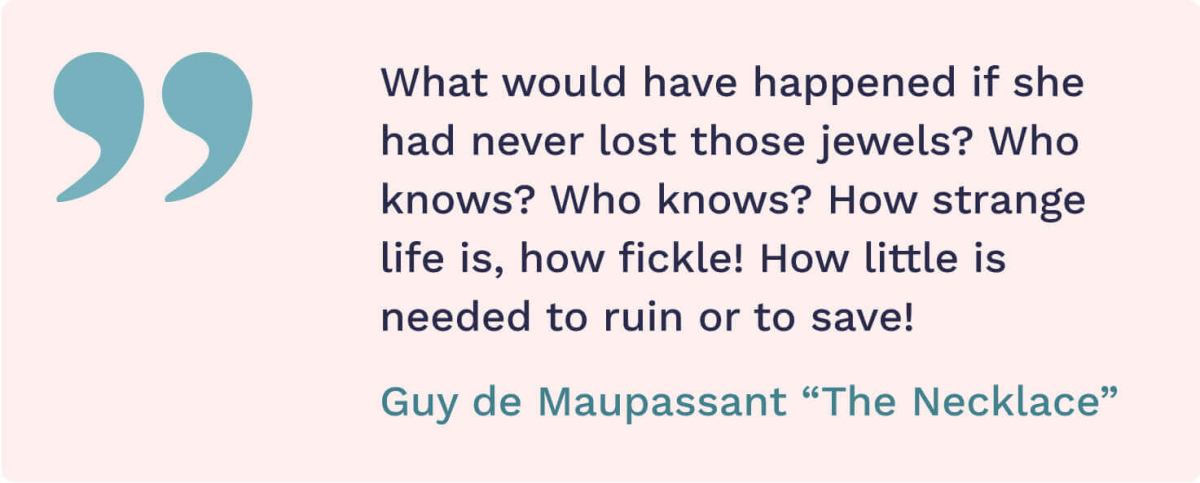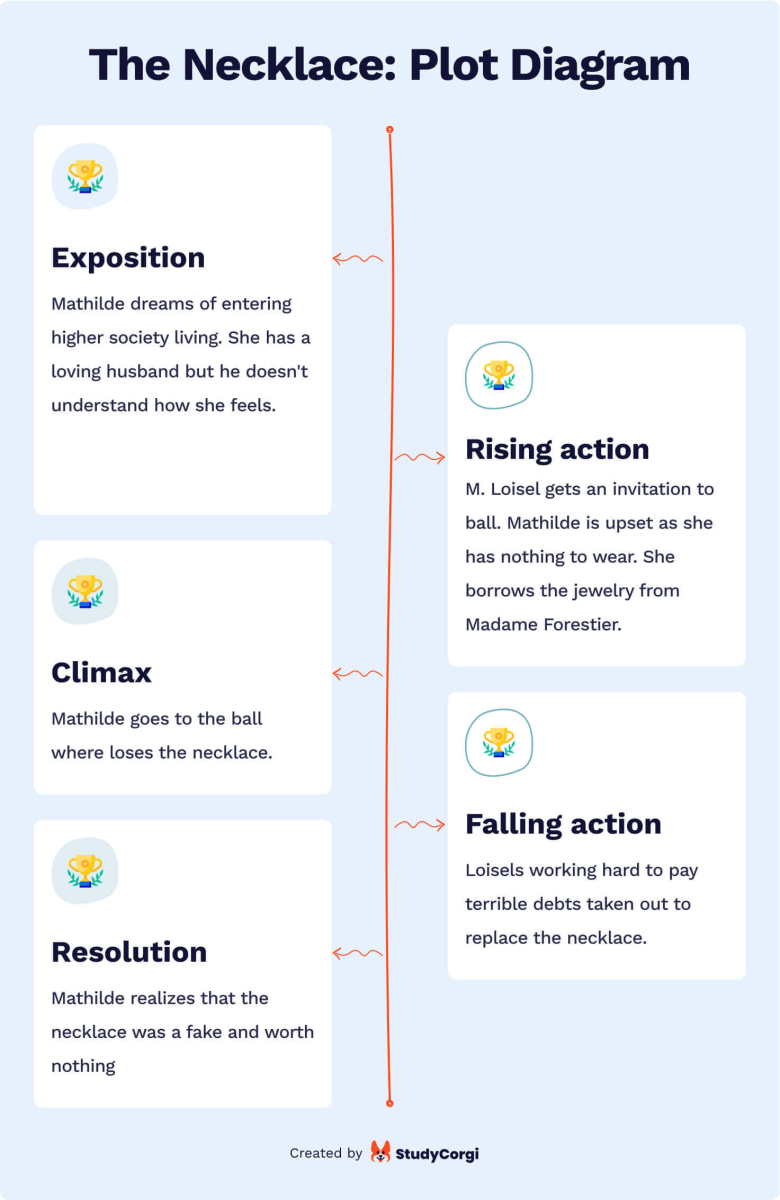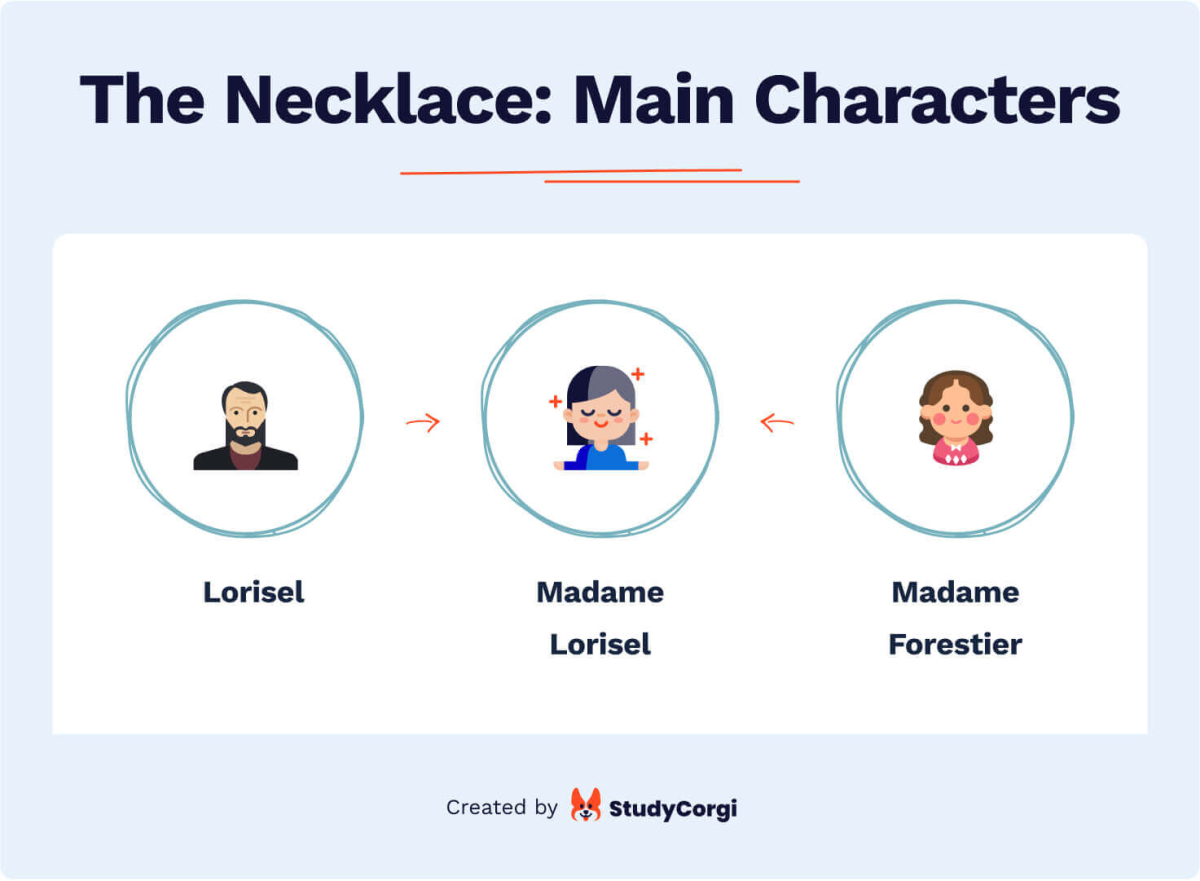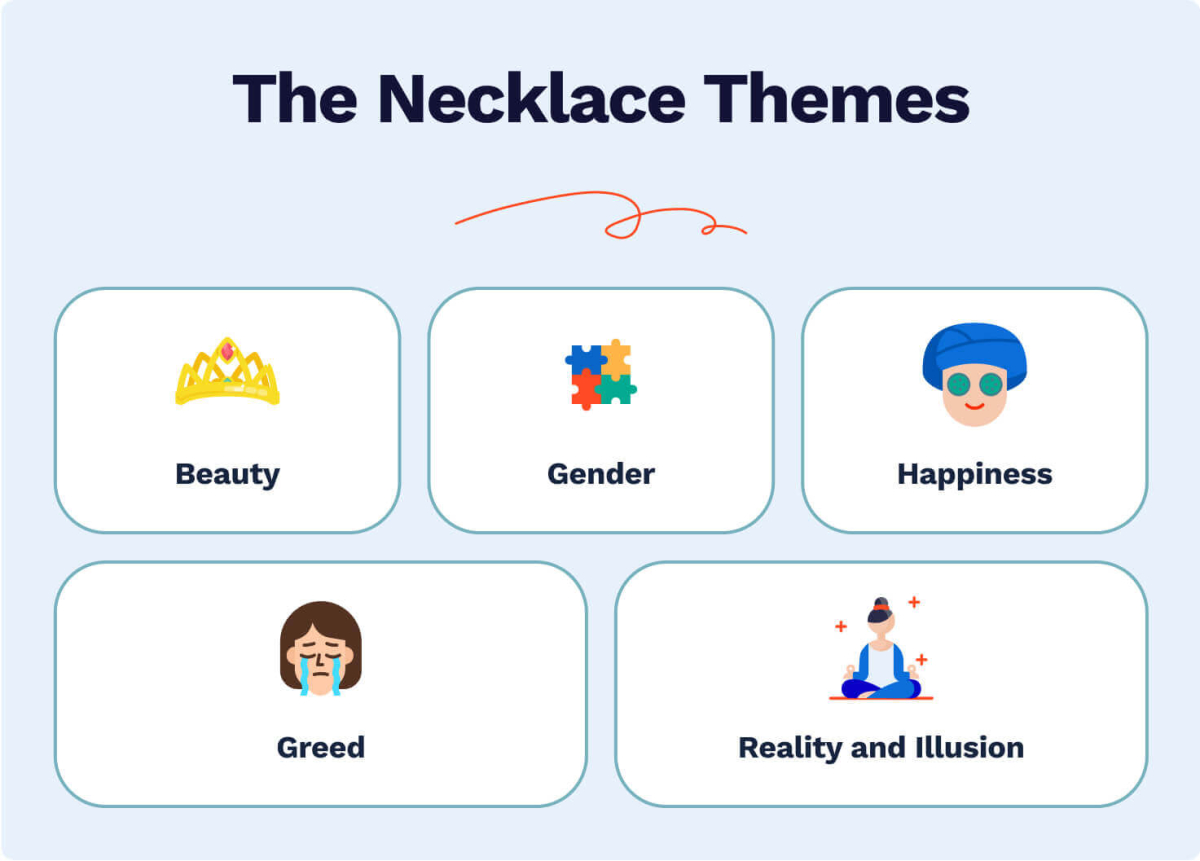The main theme of The Necklace, a short story by Guy de Maupassant, first published in 1884, is the illusion of wealth and the consequences of placing too much importance on material aspects of life. The story follows Mathilde Loisel, a young woman who, in her quest for luxury and wealth, finds herself deceived and unhappy.
On this page, you’ll discover a thorough The Necklace analysis, including:
- A brief summary of the story
- Plot development
- Critical analysis of The Necklace’s characters
- The Necklace themes
- Literary devices used in the story
- Essay ideas for inspiration
In addition to this analysis of The Necklace by Guy de Maupassant, we’ve compiled a collection of samples on the short story. If you’re looking for papers on other topics, our 100% free essays are always here for you!
The Necklace: Summary
Guy de Maupassant, an acceptable expert on human souls, wrote this novella at the end of the 19th century. “The Necklace” is a tragic and philosophical work.
The author tells the life story of an elegant and charming girl, Mathilde Loiselle. She is from a clerk’s middle-class family who could not afford a dowry. That is why she has no hopes of becoming a part of the upper class. In despair, she marries a petty official from the Ministry of Education.
Mathilde dreams about spacious salons, shining silver, fine dinners, and other ordinary things of the privileged. She dreams of being sought after. In reality, everything around brings her misery, starting with the poorness of her home, plain clothes, and food. Even the maid who runs their humble household evokes sadness for her unfulfilled desires.

Mathilde refuses to accept her life as it is. That is why she constantly cries in anguish and despair.
From time to time, she visits Jeanne Forestier, her wealthy friend. Every time she returns home, she swears she will never go there again.
One night her husband gives her a surprise. He gifts her a large envelope with an invitation to the ball. The entire higher officials, and the minister himself, are to attend that ball. M. Loisel got the invitation through a lot of effort. However, instead of getting excited, she grudgingly throws the invitation on the table.
The problem is she has nothing proper to wear. She is afraid of showing herself as a poor little slob. M. Loisel solves this challenge by giving her 400 francs he had set aside for the hunting gun.
She buys a pretty dress but still is unhappy. Now she complains she has no jewelry and looks meager and poor. M. Loisel once again comes up with a great solution. He advises her to borrow one from Mme. Forestier. She consents and goes to her friend’s house to borrow a piece of jewelry for the ball.
Mme. Forestier kindly agrees and lets her choose from a diverse collection. Mathilde spends a long time trying on each piece of jewelry until she finds the perfect one. She decides on a diamond necklace in a black satin case.
Admiring her look, she is finally happy and ready for a ball.
Her visit was a great success. Everyone was curious about her. Many of the men wanted to waltz together. The evening was unforgettable: there were no hassles and sad thoughts.
By the end of the night, she realizes it is all over for her. M. Loiselle, in turn, has to be back at his office at ten o’clock.
When they return home, she reveals her necklace is missing. Spouses start looking for it everywhere: in the folds of the dress, cloak, and pockets. But to no avail. Then the husband goes in search of the necklace on the way home. Unluckily, walking the entire route, he returns without it.

It is a big shame for her to admit the loss. So, they decide to replace the necklace with the similar one costing 40000 francs. M. Loisel takes 18000 francs inherited from his father. The spouses borrowed additional sums from friends, loan sharks, and moneylenders.
Having scraped together all the money, they buy a new necklace and give it back to Mme. Forestier.
Through ten difficult years, they manage to pay all debts. However, money is not everything they have paid. M. Loisel takes an additional night job of accounting and documents copying. Mathilde does heavy housework and losses her beauty and youthfulness. Everything she has is a warm memory of being admired in that one ball.
One day Mathilde suddenly bumps into still pretty-looking Mme. Forestier. Due to drastic changes, Jeanne hardly recognizes her charming old friend. Mathilde dares to tell her story of the life-changing debt. Being shocked, Mme. Forestier informs her that all the torment was for nothing. The original necklace was worth 500 francs at most.

The Necklace: Plot
Now let’s make a quick plot summary. Here are the main plot parts:
- Exposition. The Necklace exposition introduces the readers to the no-name protagonist. She is far from being a princess from a fairytale. She is just a daughter of middle-class parents, who cannot afford to let her enter higher society.
- Rising action. The Necklace rising action starts when M. Loisel brings an envelope with an invitation. He worked hard so the boss could host it to him. Hoping to cheer her up, he gives her a chance to attend a ball full of high society. However, Mathilde gets upset as she has nothing to wear. She borrows jewelry from Madame Forestier. After all, they’re getting ready to go to the ball.
- Climax. Mathilde gets what she needs: being beautiful, admired, and desired. Until she realizes she lost the borrowed “diamond” necklace. That is the climax of the story.
- Falling action. The story’s falling action is Loisels working hard to pay terrible debts taken out to replace the necklace for the next decade.
- Resolution. The Necklace resolution is Mathilde confessing the necklace loss and replacement to Madame Forestier. She realizes that the necklace was a fake and worth nothing.
The Necklace by Guy de Maupassant: Analysis
Prepare for The Necklace analysis! The upcoming sections will introduce the main characters’ traits, central themes, and setting.
Are you ready? Let’s go!

The Necklace: Main Characters
Here is the list of the Necklace characters and their brief description:
- Mathilde Loisel. Mme. Loisel comes from a family of clerks. Matilda has distinctive delicate and picturesque feminine beauty. As a vagrant, the girl has no chance of a lucrative marriage to find herself in a higher caste.
Her delicate, fragile, subtle sense of wealth suffers outside the desired circle of high society. Mathilde eventually becomes strong and hardworking. Her former bashfulness is replaced by the simple, working-class honesty of paying their debts in full. - M. Loiselle. M. Loiselle is a solid character from the story’s very beginning. Mr. Loiselle, unlike his wife, does not suffer from this kind of aristocratic mania. He is proud of his work. Loiselle loves his wife and is willing to give her everything he has. He happily eats the cabbage soup that disgusts Mathilde.
M. Loiselle takes the loss of the necklace with due humility. Being the man of exceptional honesty, he solves the problem by giving up his inheritance and routine life in an apartment with servants for the momentary pleasure of the woman he loves. - Jeanne Forestier. She is a better-off friend of Mathilde. They attended the same convent school. Mme. Forestier is a vividly bourgeois character: rich, indulgent, and unfailingly kind to Mathilde. She lets her borrow an expensive-looking necklace from the marvelous collection.
Finally, all her wealth turns out to be superficial: the necklace is made of fake diamonds. Jeanne is so used to this deception that she does not even think it is necessary to inform Mathilde about it.

What Is the Author’s Message in The Necklace?
“The Necklace” is a story of a woman who longs for more in life and a mistake that leads to a terrible price she must pay for her dreams to come true. The author tried to question the truth about human values by telling it. His message is clear: one should be content with whatever they have.
Maupassant’s “The Necklace” carries a solid moral. It shows that appreciating the reality you live in is an outstanding personal trait, as opposed to greed and jealousy. Life isn’t about social status or how rich you are. It is about what kind of person you are.
The Necklace Themes
Now let’s look at the themes Guy de Maupassant uncovers in the story.
Beauty
Guy de Maupassant begins the story by exposing the beauty and grace of the protagonist. The author questions the fundamental nature of beauty: is it something inherent or endowed with social status.
First, he examines the question through the example of Mathilde herself. She feels desired by many men at the ball. However, it is unclear: is it because of her stunning beauty or thanks to her expensive-looking necklace.
Then, Guy de Maupassant extrapolates the question on the example of the necklace. Even made of fake diamonds, it looks gorgeous as a proper attribute of the aristocracy.
Gender
As much gender played a significant role in the society of 19th century France, as it is one of the central themes in the Necklace. Mathilde is dissatisfied with her life and social status as a woman. At the same time, as a woman, she has nothing to do to change this.
The only possible option is to marry someone of the upper class. Mathilde’s beauty, intelligence, skills cannot help her. Lucrative marriage has been the only way for a better life for her and other women at that time.
Reality and Illusion
During the biggest part of the story, the author draws the protagonist’s difficulty distinguishing reality from illusion. She prefers to live in the elusive world of prosperity and banquets. On the contrary, her husband does not daydream. He enjoys his life and is grateful for life’s every single aspect.
The unexpected story’s final twist proves that appearances, especially the appearance of wealth, are often at odds with reality.
Greed
One more central idea of the Necklace is greed and its influence on one’s destiny. The author wants to tell the reader that one of the reasons for Mathilde’s ongoing anguish of a rich life is basic human greed.
Her life is not much unbearable or terrible. The problem is she can’t admit that anyone lives beyond her possibilities. That is perfectly illustrated by how desperate she is every time returning from her wealthy friend’s house.
Happiness
Happiness has no deals with this short story at first sight. In reality, it is one of the story’s uplifting themes.
The initial unhappiness of Mathilde appears like her personal choice. She lives an enjoyable middle-class life. It is not that difficult to be content with it. Instead of focusing on the good things, she obsesses over what she doesn’t have, causing depressive thoughts.
Even a single moment of happiness at the ball is fleeting. The one happy night is the natural effect of a stunning look and diamond necklace rather than the real Mathilde experience.
However, once spouses have been paying debts for a decade, she seems content and nostalgic. She is happier than ever before. Having uncovered the truth about the lost necklace to Jeanne, she “smiled with a proud and simple joy.”
Let’s move on to the setting of the Necklace.
The Necklace Setting
Maupassant does not directly name the time or location. Although, he lefts many hints as to which city is the setting for The Necklace.
Using the currency, which is francs, titles “M.” and “Mme.”, naming the most famous street “Champs Élysées Avenue” let us quickly get the idea that the story’s location is in Paris, France. What’s more, the ball takes place in the heart of Paris — at the Ministry of Education.
Speaking of the time, we can draw a parallel between the ironic and pessimistic narrative tone and the realms of 19th century Paris life. The majority of middle-class families financially struggled then. The highlighting attribute is a marriage built on no more than financial benefit.
Literary Devices in The Necklace
Maupassant uses many literary devices in “The Necklace.” Once again, the story is written in an ironic, pessimistic, and tense tone. The author matches the bitter narrative with the emotional state of a protagonist.
✨ Symbolism. The most prominent literary device in the Necklace is symbolism. The Necklace is a symbol of wealth. The very Necklace represents desire and all the things she did not have in her life. Secondly, their apartment with frayed walls symbolizes her present or actual state of life and how miserable she feels.
✨ Methaphor. The Necklace metaphor is, again, the Necklace itself. It serves as a metaphor for Mathilde’s pride. Mathilde refused to go to the ball unless she had a necklace and dress worthy of her high opinion of herself. She compares herself to a beggar without a dress and a necklace.
✨ Irony. Another literary device is The Necklace situational irony. The fact that M. Loisel and her husband spend their entire life collecting money for a genuine necklace that replaces the fake one is ironic.
✨ Foreshadowing. Describing the Loisel family’s apartment, the author gives an excellent example of foreshadowing in The Necklace. Decrepit furniture, abraded chairs, curtains, worn walls disturb and torture Mathilde by being not appealing and cheap.
✨ Alliterations. Maupassant uses several alliterations in the Necklace. The phrases “humble housework,” “seductive and sought,” “dreadful debt,” and “stopped, stupefied” are examples of alliterations.
✨ Internal conflict.Internal conflict in The Necklace is that being beautiful and elegant is not a key to her happiness. She thinks happy life comes along with diamonds and luxurious halls. In reality, it’s far from that.
The Necklace: Essay Ideas
You’ve finally approached “The Necklace” essay ideas! Check them out to kickstart your paper.
Essay Topics
We gathered a list of extended essay topics and The Necklace questions to uncover in your paper.
- What kind of character is Mathilde Loisel in The Necklace?
Examine the protagonist in various circumstances: turn her inner self inside out. Describe her traits and give examples of how they influence the character’s decisions and actions. - What are the examples of symbolism in The Necklace?
What is a symbol in the novel? What is its role? List the symbolic elements used by Maupassant and give their detailed explanation. - An overview of philosophical questions raised in The Necklace by Guy de Maupassant
Reflect on such philosophical issues as appearance and reality, class conflict, greed, and sacrifice, illustrated in the story. How do The Necklace events reflect the reality of that time? Are they equitable as of today? - What is the message delivered in The Necklace short story?
Formulate a message of the novel by explaining its significance, morals, author’s point of view, and appeal of The Necklace. Is there more than one thing the author wanted to tell? What did you learn from The Necklace short story? - Literary devices used in The Necklace by Guy de Maupassant
Are there any examples of figurative languages, like personification, symbolism, or similes in the novel? Make a listed overview of literary devices used in the story and give their examples. What is The Necklace’s tone? - The historical context of The Necklace by Guy de Maupassant
When and why was the story written? What influenced Maupassant to write The Necklace? How did that time influence the novel stylistically? - What is The Necklace by Guy de Maupassant’s climax?
Study the story’s plot diagram. That events do occur in the climax? How the author develops them? - The actual root causes of Mathilde Loisel unhappiness in The Necklace
Focus on why Mme. Loisel was unhappy and desperate about her life. Try to figure out whether it was modest living conditions or something more profound? Please share your opinion on whether you think she found her happiness. - Should Mathilda have told Mme Forestier what happened?
What would this change? Write an opinion essay on possible story outcomes. - The transformation of Mathilde’s attitude to wealth through the story
After losing the necklace, appearance and social status seem less critical to Matilda? Why/why not? Write a detailed explanation in your essay.
20 Essay Samples
We gathered the best essay samples to inspire you to write a brilliant paper. Take a look!
More samples you may find in our rich knowledge base with various topic-related essays. Feel free to use them!
We appreciate you reading our literary analysis of The Necklace by Guy de Maupassant. Hope, you find it valuable. If so, please, save this article and use it to generate your essay or share it with a friend.
